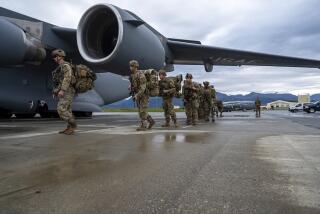Russia accuses NATO of aerial spying ‘practically every day’
Russia’s air force commander on Tuesday accused the United States and its NATO allies of provoking confrontation over the Baltic Sea by sending spy planes near the Russian border “practically every day.”
In apparent response to accusations from NATO military officials that a Russian jet flying a stealth mission nearly caused a collision with an SAS commercial jet last week, Russian Air Force commander Col. Gen. Viktor Bondarev said at a news briefing in Moscow that the Western alliance has “massively” stepped up aerial surveillance of Russia’s air defense capabilities.
“In 2014, the number of flights by reconnaissance aircraft of the United States and NATO countries over territories of the Baltic countries, the Baltic and Barents seas has increased considerably,” Bondarev said, estimating that NATO typically conducts eight to 12 such flights a week.
“Strategic reconnaissance aircraft RC-135 of the U.S. Air Force perform flights practically every day,” the Tass news agency quoted Bondarev as saying. He put the number of RC-135 flights in the vicinity of Russian borders at 140 so far this year, compared with 22 in 2013.
As relations between the former Cold War adversaries have plunged into a new phase of distrust over Kremlin aggression against Ukraine, Russian and NATO surveillance aircraft have taken to the skies in rival shows of force over the Baltic region, which was under Soviet domination for most of the previous century.
Lithuania, Latvia and Estonia were occupied and annexed by the Soviet Union at the advent of World War II, but have spun into the Western security orbit since breaking free of Moscow’s control amid the 1991 collapse of the Soviet Union. All three former Soviet Baltic republics are now part of the 28-nation North Atlantic Treaty Organization, as are Baltic Sea littoral states Poland and what was Communist East Germany during the Cold War era.
Russian President Vladimir Putin has loudly opposed the encroachment of NATO into Eastern Europe regions he considers to be Russia’s traditional sphere of influence. His armed forces seized Ukraine’s Crimea region in February after a pro-Europe rebellion in the former Soviet republic to Russia’s southeast toppled Kremlin-allied President Viktor Yanukovich.
Putin is also accused by the new Ukrainian leadership and its Western allies of sending arms and fighters to bolster the separatist movement that has wrested key areas of eastern Ukraine from the Kiev government’s control.
At his news briefing, Bondarev said NATO had also deployed AWACS -- airborne warning and control system -- aircraft on missions to survey areas in the Black Sea, Ukraine and western Russia. Those aircraft, as well as Swedish Gulfstream reconnaissance planes, German Orion P-3Cs, Danish Challengers and Portuguese Orions, have been collecting intelligence on Russian armed forces in the Kaliningrad exclave and in Baltic waters, the Russian Tass news agency said.
Bondarev’s claims appeared to be in response to mounting accusations from NATO countries that Russian aerial operations are posing a threat to the safety of civilian aircraft.
Swedish authorities Sunday protested an incident two days earlier in which a commercial flight by the Scandinavia-wide SAS group from Copenhagen, the Danish capital, to Poznan, Poland, had to be diverted to avoid colliding with a Russian spy plane flying with its transponder turned off.
“This is serious. This is inappropriate. This is outright dangerous when you turn off the transponder,” Swedish Defense Minister Peter Hultqvist told Swedish radio, referring to the aerial locater signal that identifies a plane to other aircraft in the vicinity.
Russian Defense Ministry spokesman Maj. Gen. Igor Konashenkov denied that there were “prerequisites for an air accident,” saying the aircraft were never closer than 44 miles. SAS spokesman Knut Morten also said the decision to divert the flight from its planned path had been “blown out of all proportion” and that the Russian and Scandinavian planes weren’t closer than permitted under safe air operating practices.
NATO’s Baltic Air Policing mission last week intercepted 80 Russian aircraft on 21 occasions near the borders of the Baltic states, the Lithuanian Defense Ministry said in a statement Monday. Most of the Russian spy planes were flying with their transponders turned off, the ministry said.
London-based European Leadership Network last month reported a sharp increase in Russian air operations that have penetrated or approached the airspace of NATO members. Three of the 40 incidents cited in the report were said to have had a “high probability” of causing casualties or military confrontation.
NATO reported in mid-October that the number of provocative incidents involving Russian planes and ships had already tripled over the previous year.
Follow @cjwilliamslat for the latest international news 24/7
More to Read
Sign up for Essential California
The most important California stories and recommendations in your inbox every morning.
You may occasionally receive promotional content from the Los Angeles Times.











